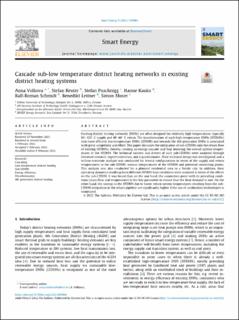| dc.description.abstract | Existing district heating networks (DHNs) are often designed for relatively high temperatures, typically 80–120 °C supply and 40–60 °C return. The transformation of such high-temperature DHNs (HTDHNs) into more efficient low-temperature DHNs (LTDHN) and towards the 4th generation DHNs is associated with great complexity and effort. This paper discusses the integration of sub-LTDHNs into the return flow of existing HTDHNs, thereby creating an energy cascade and thus lowering the overall system temperatures of the HTDHN. The technical barriers and drivers of such sub-LTDHNs were analysed through literature research, expert interviews, and a questionnaire. Their technical design was investigated, and a techno-economic analysis was conducted for several configurations in terms of the supply and return temperatures in the sub-LTDHN, various temperatures of the HTDHN and potential connecting points. This analysis was also conducted for a planned residential area in a Nordic city. In addition, their operating dynamics resulting from different HTDHN load conditions were analysed in terms of the effects on the sub-LTDHN. It was found that, on the one hand, the connection point with its prevailing conditions (mass flow and temperature) is the key parameter to ensure that the heat demand is met. On the other hand, the savings in the HTDHN due to lower return system temperatures resulting from the sub-LTDHN integration in the return pipeline are significantly higher if the use of combustion technologies is minimized. © 2022 The Authors Keywords: 4th generation district heating; Cascading; Decarbonisation; Energy efficiency; Low-temperature district heating; Sub-LTDHN | en_US |

